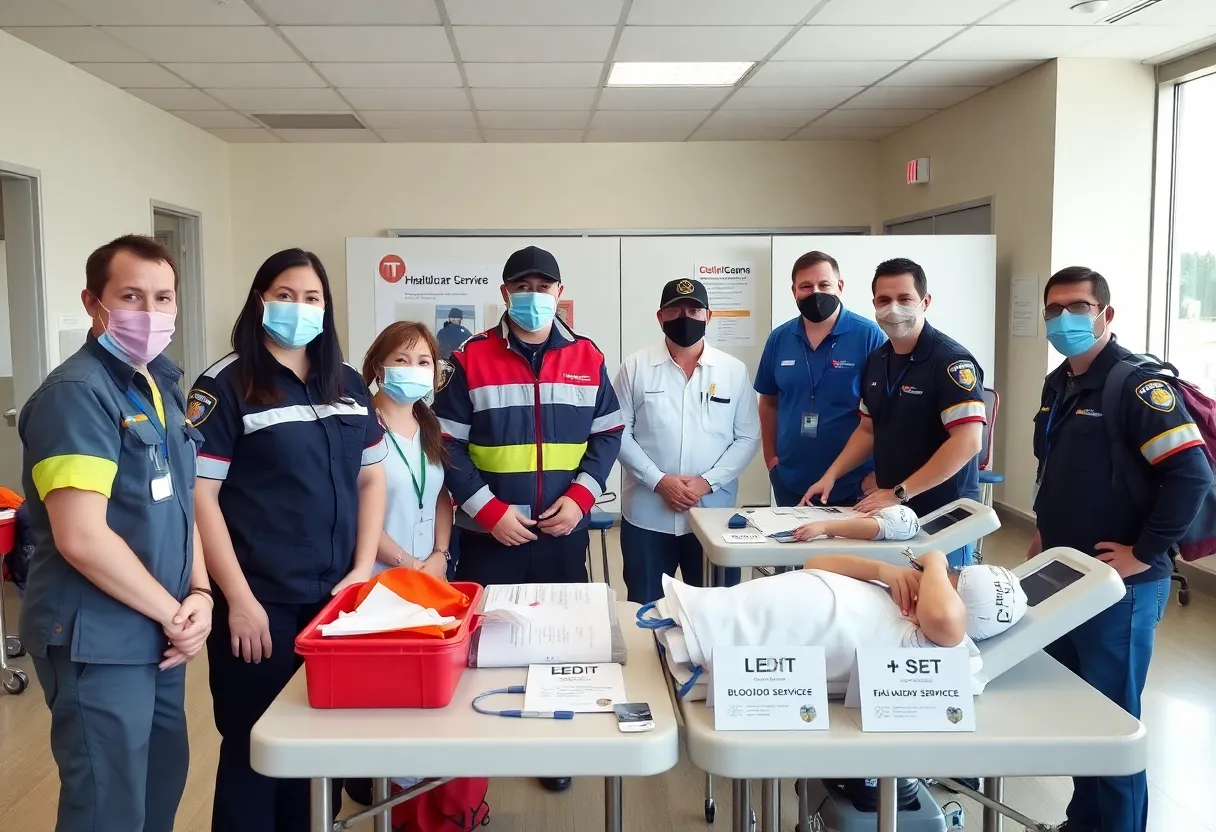Louisville, October 15, 2025
In Louisville, EMS workers organized a blood donation drive at Norton Healthcare, addressing critical supply shortages for trauma victims. Over 50 first responders participated, collecting more than 40 units of blood. The initiative highlights the essential role of blood donations in emergency care, especially amid a noted 15% decrease in nationwide donations this year, primarily due to weather disruptions. The event not only meets immediate needs but also raises awareness of the ongoing demand for blood in medical emergencies.
Louisville Blood Donation Drive by EMS Workers Addresses Supply Shortages
Louisville – In a timely effort to bolster blood supplies for trauma victims, emergency medical services (EMS) workers participated in a blood donation drive at the Norton Healthcare center. This event, occurring within the last 48 hours, saw 50 first responders contributing to the cause, emphasizing the importance of maintaining adequate blood reserves during periods of high accident rates.
The drive focused on ensuring a steady supply of blood for critical needs such as surgeries and accident responses. Organizers reported that over 40 units of blood were collected, which plays a vital role in emergency medical care. This initiative comes at a time when there has been a noted 15% decrease in donations this year, largely attributed to adverse weather conditions. The participation of EMS workers, who are on the front lines of emergency response, highlights their commitment to community health and safety.
Supporting the broader effort, the event was coordinated by local unions, fostering a sense of teamwork among participants. In addition to donating blood, attendees received wellness checks and snacks, which helped promote overall well-being and team spirit. These measures not only addressed immediate blood needs but also reinforced the role of first responders in sustaining the community’s health safety net.
Blood Donation Impact: The collected units are particularly crucial for trauma victims, as shortages can delay life-saving treatments. A paramedic involved in the drive summarized the significance by noting that each contribution directly supports emergency care, based on observations of past shortages during high-demand periods.
Further details reveal that such drives are essential in high-accident seasons, such as fall and winter, when road incidents and other emergencies increase. The 15% dip in donations underscores challenges like weather-related disruptions, which have affected donation events nationwide. In Louisville, this local effort serves as a model for how community members can step up to mitigate these shortages.
Background context on blood donation efforts shows that maintaining a reliable supply is a ongoing challenge for healthcare systems. Factors such as seasonal weather, public awareness, and participation rates influence availability. In recent years, events like this one in Louisville have become more critical due to fluctuating donation levels, making initiatives by groups like EMS workers increasingly important. This drive not only addresses immediate needs but also raises awareness about the constant demand for blood in medical emergencies.
The event’s structure included provisions for donors’ health, with wellness checks ensuring that participants were in good condition to donate. Snacks provided afterward helped maintain energy levels, contributing to a positive experience that could encourage future participation. By involving first responders, the drive also demonstrated how professional groups can lead by example in community health initiatives.
Overall, this blood donation drive in Louisville exemplifies how targeted efforts can counteract donation shortfalls. With over 40 units secured, the initiative directly supports trauma care, potentially saving lives in the process. Such events underscore the vital link between community action and healthcare readiness, ensuring that resources are available when they are needed most.
In expanding on the drive’s outcomes, officials have pointed out that the collected blood will be distributed to local hospitals, where it can be used for various procedures. This is especially important in Louisville, a city with a high volume of traffic and industrial activity, leading to frequent accidents. The 50 participants represented a diverse group of EMS workers, showcasing broad support for the cause.
To provide more depth, the 15% drop in donations this year is not isolated to Louisville; similar trends have been observed in other areas due to weather. However, local actions like this one help stabilize supplies regionally. The inclusion of wellness checks and snacks not only cared for donors but also promoted a holistic approach to health, aligning with broader public health goals.
As blood donations continue to be a cornerstone of emergency medicine, events like this reinforce the importance of regular drives. In Louisville, this recent effort stands as a proactive step toward preventing shortages, ensuring that trauma victims receive the care they need without delay.
Broader Implications
This donation drive highlights the interconnectedness of community health efforts and emergency services. By addressing current shortages, Louisville’s EMS workers are contributing to a larger network that supports healthcare across the region. The event’s success could inspire similar initiatives, helping to maintain blood supplies during challenging times.
In conclusion, the blood donation drive in Louisville represents a significant step in enhancing emergency medical resources. With participation from 50 first responders and over 40 units collected, it effectively counters the 15% dip in donations due to weather, ensuring that trauma victims have access to vital blood supplies.
FAQ
- What was the main purpose of the blood donation drive in Louisville? The main purpose was to ensure a steady supply of blood for trauma victims, with 50 first responders contributing at the Norton Healthcare center.
- How many units of blood were collected during the event? Over 40 units of blood were collected during the drive.
- What caused the 15% dip in donations this year? Officials noted a 15% dip in donations this year due to weather.
- What benefits did participants receive? Participants received wellness checks and snacks, fostering team spirit while aiding the community’s health safety net.
- Who organized the blood donation drive? The drive was organized by local unions.
Key Features Chart
| Feature | Details |
|---|---|
| Number of Participants | 50 first responders |
| Units Collected | Over 40 units |
| Donation Dip | 15% due to weather |
| Benefits Provided | Wellness checks and snacks |
| Organizer | Local unions |
| Purpose | Ensure steady supply for trauma victims |




